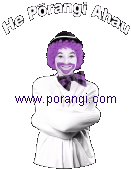Now that you have practiced your pronunciation (you did, right?) we can start learning some words and sentences. Remember that I will be doing things differently (you can call it "the pōrangi way"). All words will be analyzed so that you know what the different parts mean, together with the actual meaning of the words. I will also try to mention other words which are similar but have a different meaning. To make things worse, I will even mention when the same word would have a different meaning. Let's get started...- The first phrase is "Kia ora". It is usually pronounced "KYAo-ra" (as one word = quite quickly since people use it all the time) (remember that the "r" is a Māori "r"). The meaning is "Hello" (an informal hello, should be used with someone you know). "Kia" means "be" and "ora" means "healthy" / "well" / "alive", so by saying "hello" you are actually wishing him good health which is a very nice concept.
I will get to the formal "hello" later on, don't worry. For now you should stick with "Kia ora". - To make the conversation awfully short, we will now say goodbye... In Māori there are several ways to say goodbye.
- If you are saying goodbye to someone who is leaving, you say "Haere rā" (don't forget how to pronounce Māori words!) which means "go there" ("Haere" = "go", "rā" = "there"). If "there" sounds too tough for you, you can use another meaning for "rā" which is "sun", and say to yourself that you are wishing him to go off into the sunset... How romantic...
- If you are the one leaving and you are saying goodbye to the one staying behind, you say "E noho rā" which means "stay there" ("noho" = "sit" / "stay", "rā" = "there"). Ah yes, you can always think "don't get up, enjoy the sun, just don't forget sunblock.
- If you are not sure whether you are the one leaving or staying or you just got completely confused, you can always use "Hei konei rā" (remember to put the emphasis on the first syllables of words) which is a more informal way of saying goodbye, and means "for here there" ("Hei" = "for" / "at", "konei" = "this place" / "here", "rā" = "there"). Wherever you go, here or there, go with the sun...
Now spend some time with a friend, your kids, or some strangers in the street, and practice your "hello"s and "goodbye"s.After you are arrested for saying weird things to strangers, get put in a mental institution and manage to get released from the mental institution, make a note for next time to bring your pōrangi identity card with you.The word "you":- In Māori we need to count up to three when saying "you". To say "you" to one person, we use the word "koe" (it's pronounced like "koh-eh" or "kweh", not "kohw"! Go back and practice the pronunciation rules), to say "you" to two people, we use the word "kōrua" (notice the macron - give the "o" the emphasis and make it a bit longer), and for three people we use "koutou". The "ou" vowel combination (try to say it yourself) will end up sounding closer to the full English "oh" (including a bit of the "w" sound at the end). Note: "o" is without the "w" sound and "ou" gets a bit of the "w" sound. Remember to practice your pronunciation rules...
You will be finding many words in Māori with "ua" or "rua" for two people and "tou" for three people or more. Actually, "rua" means "two" and "toru" (which is close enough to "tou") means "three". - Now that you know how to say "you" in three different forms, the formal way of saying "hello" to one person is "Tēnā koe" ("Tēnā" = "that", "koe" = singular "you"), "hello" to two people is "Tēnā kōrua", and "Tēnā koutou" is for three or more. Saying "that is you" as a formal "hello" is to formally acknowledge the existance and the importance of the other person/people.
- Now you can ask how the other person is doing: "Kei te pēhea koe?" = "How are you (singular) doing" ("Kei te" = present form, "pēhea" = "how are", "koe" = singular you). And of course we should also use "Kei te pēhea kōrua?" and "Kei te pēhea koutou?".
- The answer would probably be: "Kei te pai" ("Kei te" = present form, "pai" = "good") or "Kei te pai ahau" ("ahau" = "me") which means "I am fine".
Summary:We learned how to say "hello" ("Kia ora", "Tēnā koe", "Tēnā kōrua" and "Tēnā koutou"), "how are you" ("Kei te pēhea koe?", "Kei te pēhea kōrua?" and "Kei te pēhea koutou?"), "I am fine" ("Kei te pai" or "Kei te pai ahau"), and "goodbye" ("Haere rā", "E noho rā", and "Hei konei rā"). Once you have gotten all that, you can move on to the next lesson... |
